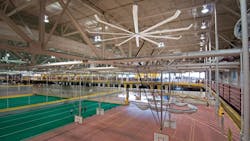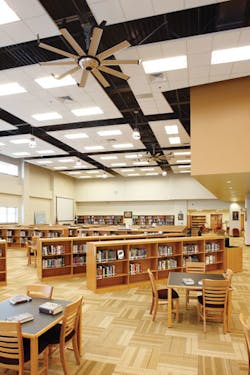Improving Learning With Better Air Quality
Somewhere between the advent of air conditioning and the fear of rising energy costs, the idea of air movement was lost. Air conditioning enabled people to close windows and provide a cool, comfortable temperature in which to live, work and learn. Jump forward a few decades, and the year-round cost of using HVAC systems, whether for summer cooling or winter heating, is making people rethink their reliance on them. The one constant that seems to be overlooked, though, is the use of air movement, which provides comfort on its own or from accompanying mechanical systems.
It’s not just comfort that gives air movement a secure job. Working with HVAC systems, air movement from large-diameter, low-speed fans provides an energy-efficient alternative for creating an engaging learning environment and helps curtail indoor air quality (IAQ) concerns that plague education facilities of all ages. This increased air circulation turns over the air in a space several times per hour. It provides a more constant, uniform temperature that inhibits mold growth, and the gentle, quiet operation does not add any unwanted acoustics to the environment.
Fan mechanics
Along with understanding the importance of airflow, facility managers should recognize how these effects are achieved mechanically. Properly engineered, large-diameter, low-speed fans use their immense size—not speed—to move a massive amount of air in areas where traditional, high-velocity fans are rendered ineffective. When the airfoil length is doubled, the surface area that those airfoils sweep is quadrupled. As the size gets larger, the amount of air the fan moves increases at a much faster rate than the amount of power needed to turn the fan as the size gets larger. So, all things being equal, the fan will become more efficient.
The pitch, or angle of attack, at which the airfoil is positioned, also helps determine the effectiveness of a fan. An exaggerated pitch—airfoils with an almost vertical angle of attack—will either increase drag (and possibly increase energy draw); a flat, mostly horizontal airfoil typically will not move much air at all. The most efficient angle lies somewhere in between. Operational speed and airfoil size and shape also affect the performance of a fan. Optimal fan design combines the most air movement with the least amount of energy use. The key is finding the optimal combination that produces the most air movement with the least amount of energy.
The sum of two parts
Poor IAQ and variable comfort thresholds can make the process of pleasing all occupants difficult. A 2000 U.S. Environmental Protection Agency (EPA) study, “IAQ Tools for Schools,” found that student attendance rose 5 percent after incorporating cost-effective indoor air quality improvements. The study also cites “a large body of research linking health and productivity with specific building design operation attributes,” including indoor air quality, lighting levels, airflow, humidity and temperature.
ASHRAE (American Society of Heating, Refrigerating and Air Conditioning Engineers) Standard 55-2010 uses a combination of six primary environmental and personal factors to determine which thermal environmental conditions are acceptable to building occupants. Comfort levels differ widely; a thermal environment that is acceptable to at least 80 percent of the occupants is considered an acceptable level of thermal comfort per Standard 55. ASHRAE also has set standards on the amount of outdoor air necessary in spaces with HVAC systems to counter the off-gassing of contaminants in indoor spaces.
Adequate IAQ typically is a concern in the occupant breathing zone, which is considered to be between 3 and 72 inches from the floor. With a traditional HVAC system in the winter, only about 80 percent of the fresh air brought into a space reaches the designated occupant level. Based on square footage, capacity and usage, minimum requirements have been established for the amount of fresh air that needs to be brought into a space. Given these requirements, some systems are forced to overcompensate. Considering hot air is less dense than cold air and tends to rise, heating systems are forced to compensate for the lost air to create a space that complies with ASHRAE Standard 62.1-2010, Ventilation for Acceptable Indoor Air Quality, increasing costs.
Installing large-diameter, low-speed fans between the supply air discharge and the ceiling return circulates the air down to the occupant level, reducing the amount of ventilated air required in the space. Facility designers can use large ceiling fans to circulate conditioned air throughout the space and reduce their fresh air intake for traditional HVAC systems by up to 20 percent without a negative effect on IAQ.
Sidebar: Texas heat
It’s hard to bypass air conditioning during a Texas summer, but Rainey Lann, director of facilities for Hutto High School in Hutto, Texas, opted for a tandem system of ceiling fans and HVAC to reduce operating costs and supply a comfortable environment for students.
The 9,350-square-foot library has 20- to 24-foot-high ceilings. West- and south-facing windows bring in the desired natural night—along with unwanted heat. Lann says ceiling fans were specified from the beginning as both a design element and potential energy-saving device to reduce air-conditioning costs. With up to 60 students using the library throughout the day, air movement was essential, so two 8-foot large-diameter, low-speed fans were installed to circulate air within the space.
The specified 35-ton air-conditioning unit was installed; with the air movement provided by the ceiling fans they were able to raise the thermostat setpoint from 72ºF to 74ºF. This setpoint increase, says Lann, saves 5 to 8 percent in cooling costs and keeps the temperature more even across the entire library than air conditioning alone could achieve.
Wolgelenter is a senior writer for the Big Ass Fan Co., designer, engineer and manufacturer of large-diameter, low-speed ceiling and vertical fans in Lexington, Ky.

